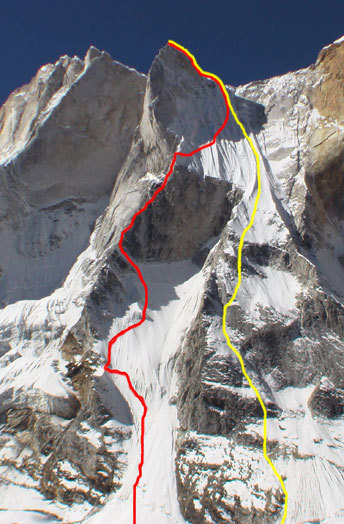
Meru Central (6310m) in India’s Gangotri Region, showing the route (VI 5.11d M5 80 degrees, ca. 2000m), in red, climbed by Czechs Marek Holecek and Jan Kreisinger in October. The yellow line is Shangri La (ED 5.9/5.10 A1/A2 M5 75 degrees), established by Valeri Babanov in 2001. The Shark’s Fin is the 400-meter-high prow of stone that leads to Meru Central’s summit. Despite numerous attempts, the Shark’s Fin remains unclimbed. [Photo] Jan Kreisinger
On October 6 Czech mountaineers Marek Holecek and Jan Kreisinger made possibly the second ascent of Meru Central (6310m) in India’s Gangotri Region. Although initial reports, published while the pair was still touring India after the expedition, pronounced that they had climbed the stupendous Shark’s Fin, the object of desire for many expeditions in the past, these proved incorrect. However, the pair did complete a partial new route.
Holecek and Kreisinger, both experienced alpine big-wall climbers, arrived at Tapovan Base Camp on September 18 and acclimatized by bouldering in the vicinity until the 23rd. The next day they set off, planning to make a capsule-style ascent of the Shark’s Fin, the prominent nose of granite that forms the northeast pillar of the mountain. Hauling a portaledge and using 200 meters of fixing rope, they started the route on the 25th and made Camp 1 the following day at 5250 meters. By October 2 they had reached the base of the fin and established Camp 3 at 5900 meters. The next day, following the line of previous attempts, they slanted up the icy chimney feature leading to a corner toward the left edge of the headwall.
By October 4 the pair had been on the route for nine days: they’d hauled a lot of gear, were now very tired and Kresinger was beginning to feel a little ill. They reluctantly made the decision to abandon the fin, and on the 5th Holecek climbed a rock step on the right side of the prow to reach the upper snow face. The following day they traversed up and right into the center of the face. As snow conditions were bad and there was no possibility of placing protection, this proved a highly dangerous section. However, once they reached a pronounced snow/ice rib in the upper part of the face and connected with the original route climbed by the Russian Valeri Babanov in 2001, conditions improved and in another seven long pitches they reached the summit ridge. From here it was just a short and easy ascent to the highest point.
After spending the night just below the summit ridge on the descent, they regained their portaledge the following day and by 2:30 p.m. on the 9th had reached the foot of the face. The ca. 2000-meter climb was rated 5.11d M5 80 degrees, took 13 days and required the drilling of two bolts. Another party in the area reports that a Korean team may have also climbed the mountain, but so far this cannot be confirmed.
Prior to 2001 attempts on the unclimbed Central Summit of the Meru peaks had been via the compelling line of the Shark’s Fin: a long ice slope, followed by a difficult rock ridge to the impressive 400-meter-high prow that gives the line its name. In the spring of that year one of the suitors was Valeri Babanov. He failed at 5800 meters, but undeterred, came back in the autumn and soloed the snow and ice face to the right, finishing along the northwest ridge. This ascent, named Shangri La (ED 5.9/5.10 A1/A2 M5 75 degrees), won the Russian the Piolet d’Or.
The Shark’s Fin has now repulsed numerous first-rate climbers apart from Babanov. These include Conrad Anker, Nick Bullock, Jules Cartwright, Doug Chabot, Jonny Dawes, Bruce Miller, Paul Pritchard, Mugs Stump and Pete Takeda. The best attempt so far has probably been that of Bullock, Cartwright and Jamie Fisher, who in 1997 climbed to ca. 6100 meters on the left side of the prow before retreating.